 |
|
1938
|
|
Shotesham Mill
River Tas |
 |
|
1938
|
|
Shotesham Mill in Shotesham St. Mary or Low Shotesham as it was in 1836, was built in the 1700s and spent its last years working as a grist mill. It finally stopped working towards the end of the second world war when the last miller retired, before being demolished in 1949 after being badly damaged by floods. Apparently, at the time of its destruction it was described as "The little gem of Norfolk scenery." The mill was almost saved, when at a meeting of the East Norfolk Rivers Catchment Board it was stated that the preservation of the mill was possible and Mr. Fletcher Watson, the architect, said that he had a client who was willing to restore the mill. Unfortunately it never came to pass. |
Shotesham watermill stood to the southeast of the nearby post_windmill, the two mills being worked by the same miller.
|
 |
c.1930 |
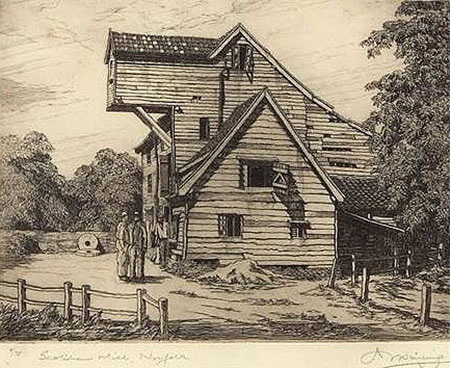 |
Print by James Starling - c.1935 |
 |
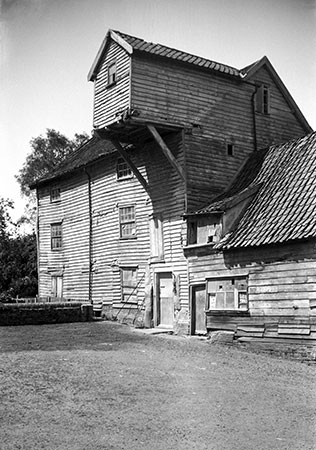 |
3rd June 1939 |
29th May 1939 |
Notice to Creditors |
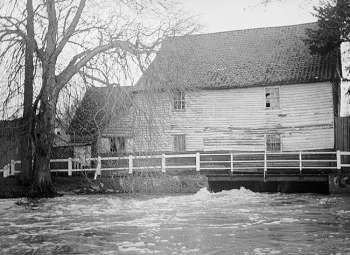 |
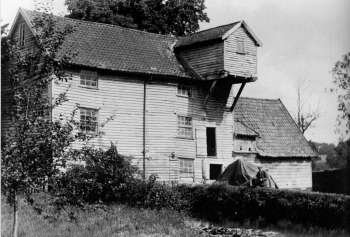 |
|
Tailrace in 1938
|
c.1938
|
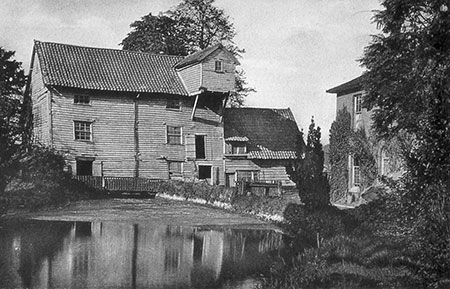 |
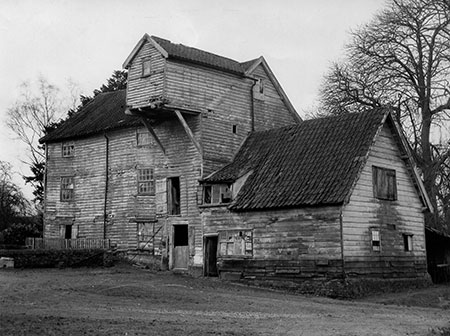 |
Mill dam c.1947 |
c.1947 |
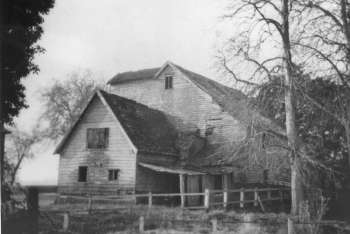 |
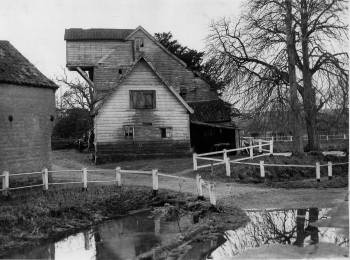 |
|
1947
|
1947
|
| In 1263, John de Vaux of Therston obtained a charter for free warren here, of King Henry III.; this John was sued for appropriating the fishing to himself on each side of his mill, it being proved that all the fishery in the manor was common to the tenants except the mill pool only, and at the same time the Abbot of Holme was fined, for hindering the common fishing at Linewesse in Shotesham . |
|
Tofthall Manor belonged to Bishop Stigand, and at the Conquest to Roger Bigot, and Ralf Fitz Walter held it of him, as a manor containing 2 carucates of land, worth at the first survey 40 s . and at the second 4 l. per annum. Upper Shotesham was then a mile and half long, and half a mile broad, and paid 16 d . to the geld; there was the moiety of a mill, and the advowson of a church belonging then to the manor, and the moiety of the advowson had 15 acres of glebe, then valued at one penny an acre per annum. |
|
The church of All-Saints, called high or Great Shotesham church, which was given by Sir Robert de Vaux, founder of Pentney priory in Norfolk, to that house when he founded it, and so it became separated from Shotesham -Hall manor, which it constantly had attended to that time; and Ralph de Hoe released all his right in it; the same founder also gave to that house, a mill at Shotesham and 15 acres of land late belonging to the church; and the advowson of St. Botolph's church here, and the prior got the church of All-Saints appropriated to his house, and was taxed for its spirituals appropriated, at 12 marks, and always presented to the endowed vicarage, till the Dissolution, when the whole vested in the Crown, and continued there till 1552, and then Edward VI. granted the impropriate rectory and the advowson of the vicarage , and the advowson of the churches of St. Mary and St. Botolph , to William Necton , and William Mingay and his heirs; and it hath continued in the Mingays, for in 1715, William Mingay, Gent. was impropriator and patron. |
Arthur Cole (1835-1902) was journeyman miller who travelled between many mills including Shotesham. |
|
SHOTISHAM MILLS |
John Spratt made a will on 9th April 1817 and it was proved on 13th September 1819. To ANDREW SPRATT, all that flour mill, dwellinghouse, land, hereditaments and premises situate lying at Mulbarton as is now in the occupation of said son Andrew for his heirs and assigns. |
| Shottesham All Saints Kelly's 1879: |
William Cutts, Dukes Head inn, farmer, artificial manure, & cart & mill grease manufacturer & hoop & hurdle maker |
|
Effort to Save Shotesham Mill |
|
Private Offer For Renovation |
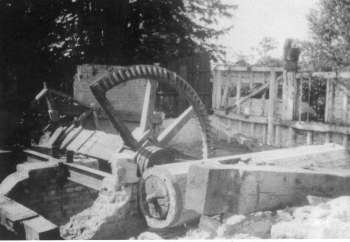 |
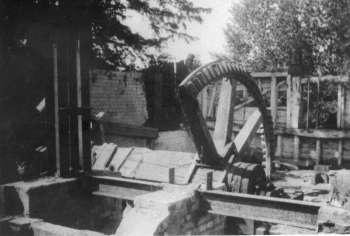 |
|
Remains of waterwheel axle and upright shaft in 1949 |
Pitwheel section during demolition in June 1949 |
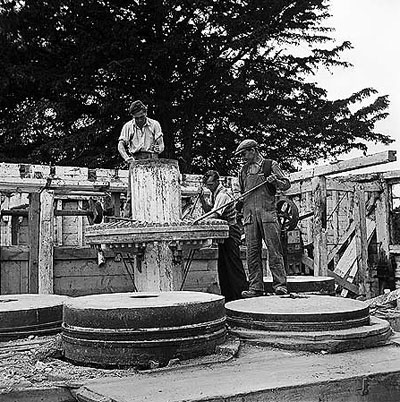 |
Destruction of the mill in June 1949 |
I am now going back a further generation to Andrew Spratt (my 5x great grandfather) and John Spratt's father. John baptismal record shows parents Andrew and Elizabeth. Andrew son of Andrew Spratt & Susannah his wife was bapt May ye 29th 1713 in Earsham. He was married on 29th October 1741 to Elizabeth Bruerton at Hedenham. He died 5th August 1788 and was buried at Shotesham St Mary on 10th August 1788. Andrew Spratt Miller aged 75. The headstone reads In memory of WILLm SPRATT who departed this life November the 21st 1751 Aged 37 years Also of ANDw SPRATT who departed this life August the 5th 1788 Aged 75 years. [William was Andrew's brother]. Unfortunately the area around the Spratt graves at Shotesham St Mary is extremely over grown with shrubs etc. and it is now impossible to be able to see and read some. (The churchyard could possibly do with borrowing some sheep and/or goats!) Yesterday I discovered on Ancestry from Briton, Country Apprentices 1710-1808, hand written, the following, from 1784: 22 May 84, No.56 Andrew Spratt & John Shottisham C. of Norfolk Millers Thos Reynolds. This seems to confirm that this Andrew Spratt was a miller at Shotesham. |
My maternal 4x great grandfather was John Spratt the miller at Mulbarton, Shotesham_postmill, Shotesham watermill and Saxlingham Thorpe postmill and watermill. |
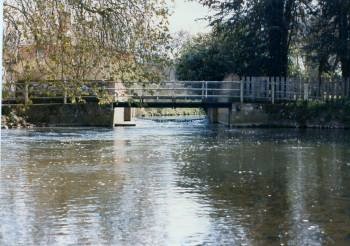 |
 |
|
Tailrace in April 1977 |
Tailrace in February 2003 |
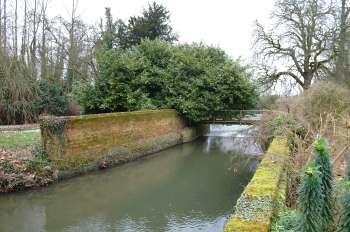 |
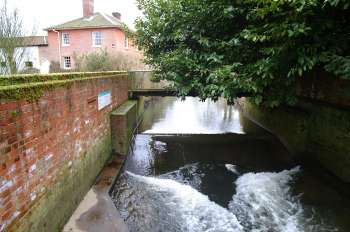 |
|
Headrace in February 2003 |
Wheelrace in February 2003 |
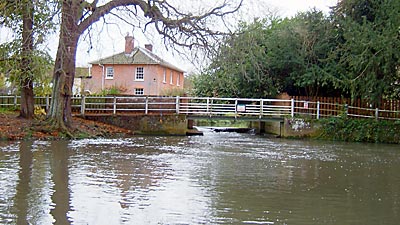 |
23rd November 2006 |
The burials records of St Mary's Shotesham of 1788 show Andrew Spratt, Miller, aged 75. There is no record of him being a miller on the grave stone. The burial record together with the details of the 1784 apprentice record stating Andrew was a miller in Shotesham I think make it safe to put this on the site. (This Andrew Spratt started out life as a carpenter in Hedenham where he was married and where his children were born. There is an apprentice record from 1751 with him being a Master Carpenter.) The earliest record of him being in Shotesham is 16th October 1776 from the Norfolk Chronicle attending a meeting together with John Spratt of Mulbarton of the subscribers to the association for the apprehending and prosecuting of horse-stealers but whether he was a miller at this time is not stated. The safest time for saying he was a miller is as late as 1784, although likely he was a miller for many years before this. However, from when, it is impossible to tell from my investigations. |
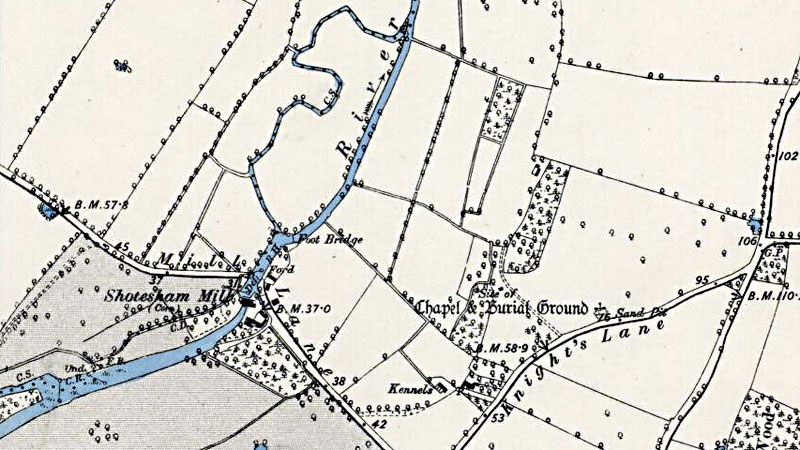 |
O. S. Map 1880 |
 |
O. S. Map 1882 |
The above map clearly shows the dotted line of the parish boundary tracing the original path of the River Tas that ran to the west of the mill rejoining the main river course to the north of the mill. The river course was altered to accommodate the mill and the mill dam.
|
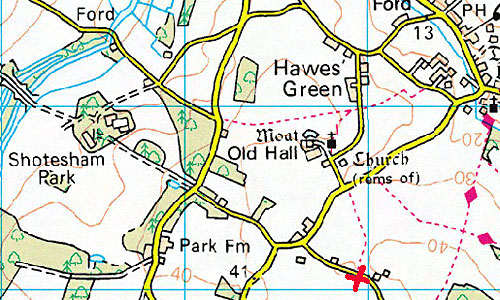 |
O.S. Map 2010 Red cross marks postmill - watermill at the ford Image reproduced under licence from Ordnance Survey |
1263: Mill working Faden's map 1797: Shotesh Mills |
| Nat Grid Ref TM 22589939 | Copyright © Jonathan Neville 2003 |